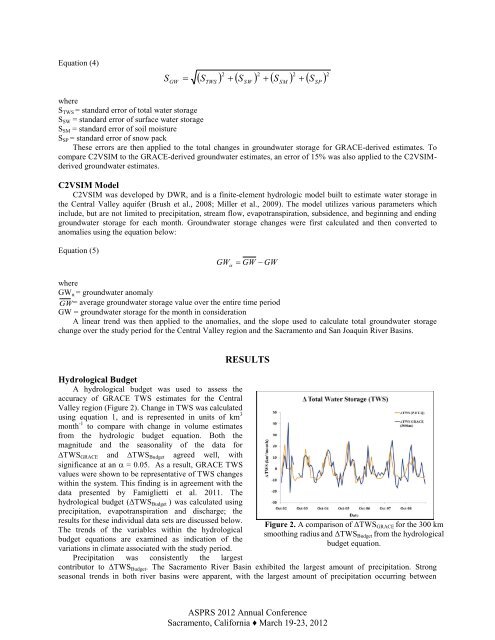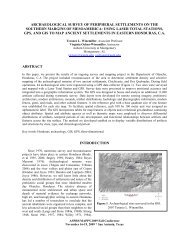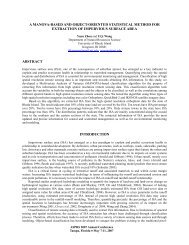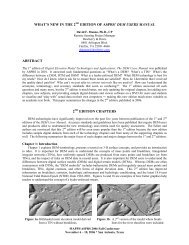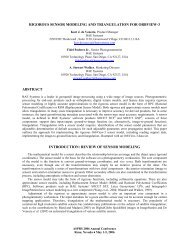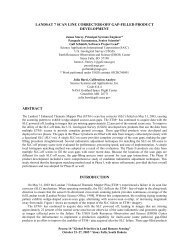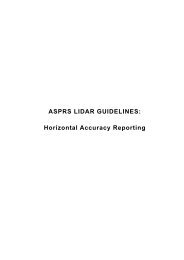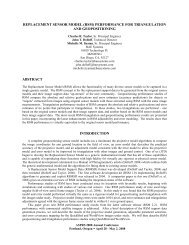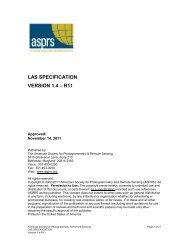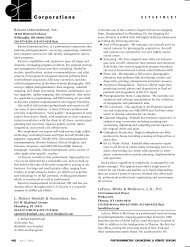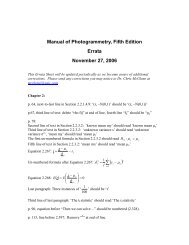comparison of changes in groundwater storage using grace ... - asprs
comparison of changes in groundwater storage using grace ... - asprs
comparison of changes in groundwater storage using grace ... - asprs
You also want an ePaper? Increase the reach of your titles
YUMPU automatically turns print PDFs into web optimized ePapers that Google loves.
Equation (4)<br />
S<br />
GW<br />
<br />
S<br />
S<br />
2<br />
S<br />
2<br />
S<br />
2<br />
2 TWS SW SM SP<br />
where<br />
S TWS = standard error <strong>of</strong> total water <strong>storage</strong><br />
S SW = standard error <strong>of</strong> surface water <strong>storage</strong><br />
S SM = standard error <strong>of</strong> soil moisture<br />
S SP = standard error <strong>of</strong> snow pack<br />
These errors are then applied to the total <strong>changes</strong> <strong>in</strong> <strong>groundwater</strong> <strong>storage</strong> for GRACE-derived estimates. To<br />
compare C2VSIM to the GRACE-derived <strong>groundwater</strong> estimates, an error <strong>of</strong> 15% was also applied to the C2VSIMderived<br />
<strong>groundwater</strong> estimates.<br />
C2VSIM Model<br />
C2VSIM was developed by DWR, and is a f<strong>in</strong>ite-element hydrologic model built to estimate water <strong>storage</strong> <strong>in</strong><br />
the Central Valley aquifer (Brush et al., 2008; Miller et al., 2009). The model utilizes various parameters which<br />
<strong>in</strong>clude, but are not limited to precipitation, stream flow, evapotranspiration, subsidence, and beg<strong>in</strong>n<strong>in</strong>g and end<strong>in</strong>g<br />
<strong>groundwater</strong> <strong>storage</strong> for each month. Groundwater <strong>storage</strong> <strong>changes</strong> were first calculated and then converted to<br />
anomalies us<strong>in</strong>g the equation below:<br />
Equation (5)<br />
GW<br />
<br />
GW GW<br />
where<br />
GW α = <strong>groundwater</strong> anomaly<br />
GW= average <strong>groundwater</strong> <strong>storage</strong> value over the entire time period<br />
GW = <strong>groundwater</strong> <strong>storage</strong> for the month <strong>in</strong> consideration<br />
A l<strong>in</strong>ear trend was then applied to the anomalies, and the slope used to calculate total <strong>groundwater</strong> <strong>storage</strong><br />
change over the study period for the Central Valley region and the Sacramento and San Joaqu<strong>in</strong> River Bas<strong>in</strong>s.<br />
Hydrological Budget<br />
A hydrological budget was used to assess the<br />
accuracy <strong>of</strong> GRACE TWS estimates for the Central<br />
Valley region (Figure 2). Change <strong>in</strong> TWS was calculated<br />
us<strong>in</strong>g equation 1, and is represented <strong>in</strong> units <strong>of</strong> km 3<br />
month -1 to compare with change <strong>in</strong> volume estimates<br />
from the hydrologic budget equation. Both the<br />
magnitude and the seasonality <strong>of</strong> the data for<br />
TWS GRACE and TWS Budget agreed well, with<br />
significance at an = 0.05. As a result, GRACE TWS<br />
values were shown to be representative <strong>of</strong> TWS <strong>changes</strong><br />
with<strong>in</strong> the system. This f<strong>in</strong>d<strong>in</strong>g is <strong>in</strong> agreement with the<br />
data presented by Famiglietti et al. 2011. The<br />
hydrological budget (ΔTWS Budget ) was calculated us<strong>in</strong>g<br />
precipitation, evapotranspiration and discharge; the<br />
results for these <strong>in</strong>dividual data sets are discussed below.<br />
The trends <strong>of</strong> the variables with<strong>in</strong> the hydrological<br />
budget equations are exam<strong>in</strong>ed as <strong>in</strong>dication <strong>of</strong> the<br />
variations <strong>in</strong> climate associated with the study period.<br />
Precipitation was consistently the largest<br />
RESULTS<br />
Figure 2. A <strong>comparison</strong> <strong>of</strong> ΔTWS GRACE for the 300 km<br />
smooth<strong>in</strong>g radius and ΔTWS Budget from the hydrological<br />
budget equation.<br />
contributor to ΔTWS Budget . The Sacramento River Bas<strong>in</strong> exhibited the largest amount <strong>of</strong> precipitation. Strong<br />
seasonal trends <strong>in</strong> both river bas<strong>in</strong>s were apparent, with the largest amount <strong>of</strong> precipitation occurr<strong>in</strong>g between<br />
ASPRS 2012 Annual Conference<br />
Sacramento, California ♦ March 19-23, 2012


